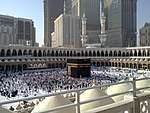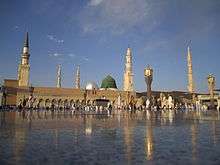Quba Mosque
The Quba Mosque (Arabic: مَسْجِد قُبَاء, romanized: Masjid Qubāʾ) is a mosque located on the outskirts of Medina, Saudi Arabia. Initially, the mosque was built 6 kilometres (3.7 miles) off Medina in the village of Quba, before Medina expanded to include this village. Depending on whether the Mosque of the Companions in the Eritrean city of Massawa[1] is older or not, it may be the first mosque in the world that dates to the lifetime of the Islamic Nabi (Prophet) Muhammad in the 7th century CE.[2][3][4] According to records, its first stones were positioned by Muhammad as soon as he arrived on his emigration from the city of Mecca to Medina,[5] and the mosque was completed by his companions. Muhammad spent 14 days in this mosque praying qaṣr (Arabic: قَـصْـر, a short prayer) while waiting for Ali to arrive in Medina, after the latter stayed behind in Mecca to carry out a couple of tasks entrusted to him by the Prophet. Also going along with traditional saying, this mosque is said to be where the first Friday prayer was held, led by the Prophet Muhammad.[6]
| Quba Mosque Arabic: مَسْجِد قُبَاء, romanized: Masjid Qubāʾ | |
|---|---|
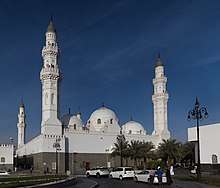 Quba Mosque in Madinah | |
| Religion | |
| Affiliation | Islam |
| Province | Al Madinah |
| Region | Hejaz |
| Location | |
| Location | Madinah, Saudi Arabia |
| Geographic coordinates | 24°26′21″N 39°37′02″E |
| Architecture | |
| Architect(s) | Abdel-Wahed El-Wakil |
| Type | Mosque |
| Style | New Classical Islamic |
| Completed | 1986 (current) |
| Specifications | |
| Dome(s) | 6 |
| Minaret(s) | 4 (current) 1 (original) |
According to Islamic tradition, performing Wuḍūʾ ('Ablution') in one's home then offering two Rakaʿāt of Nafl (Optional) prayers in the Quba Mosque is equal to performing one ʿUmrah. Muhammad used to go there, riding or on foot, every Saturday and offer a two rakaʿāt-prayer. He advised others to do the same, saying, "Whoever makes ablutions at home and then goes and prays in the Mosque of Quba, he will have a reward like that of an 'Umrah." This ḥadīth was reported by Ahmad ibn Hanbal, Al-Nasa'i, Ibn Majah and Hakim al-Nishaburi. Also going along with traditional saying, this mosque is said to be where the first Friday prayer was held, led by the Prophet Muhammad.[7]
Architecture

When the Driehaus Prize winner and New Classical architect Abdel-Wahed El-Wakil was commissioned, in the 20th century, to conceive a larger mosque, he intended to incorporate the old structure into his design. But the old mosque was torn down and replaced with a new one.[8]
The new mosque consists of a rectangular prayer hall raised on a second story platform. The prayer hall connects to a cluster containing residential areas, offices, ablution facilities, shops and a library.
The recent new construction of the Quba Mosque that happened in 1984 include many new additions, such as 7 main entrances, 4 parallel minarets, and the 56 mini domes that surround the perimeter of the mosque from an overhead point of view.[9] The courtyard of this mosque is composed of black, red, and white marble.[10] And majority of the structure and interior structures such as the minbar and mihrab are all composed of white marble. Originally, there was one minaret, the new renovations included the addition of the other three minarets, they rest on square bases, have octagonal shafts which take on a circular shape as they reach the top.
Prayer Hall
The prayer hall is arranged around a central courtyard, characterised by six large domes resting on clustered columns. A portico, which is two bays in depth, borders the courtyard on the east and west, while a one-bayed portico borders it on the north, and separates it from the women's prayer area.
The women's prayer area, which is surrounded by a screen, is divided into two parts as a passageway connects the northern entrance with the courtyard.
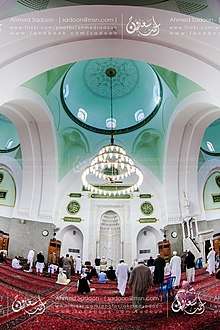
When Quba Mosque was rebuilt in 1986, the Medina architecture was retained – ribbed white domes, and basalt facing and modest exterior – qualities that recalls Madina's simplicity. The courtyard, is flagged with black, red and white marble. It is screened overhead by day from the scorching heat with shades. Arabesque latticework filters the light of the palm groves outside. Elements of the new building include work by the Egyptian architect Abdel-Wahed El-Wakil and the Stuttgart tensile architect Mahmoud Bodo Rasch,[11] a student of Frei Otto.
Landmarks
-Waterfountain
-Masjid Dirar (previously)
The Quba Mosque is the oldest mosque and one of the first in Islam. Not to be confused with the Kaaba which is the oldest sacred site in Islam. The Kaaba is not a mosque but a holy site located near the Great Mosque of Mecca.
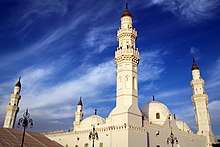
Imams and Khateebs of Masjid Quba
1) Sheikh Dr. Salih al Maghamsi
2) Sheikh Dr. Imaad Zuhayr Haafidh
3) Sheikh Dr. Ahmad bin Ali al Hudhaify
Mentions
In ahadith
The merits of Masjid Quba are mentioned in nineteen Sahih al-Bukhari hadiths; thirteen Sahih Muslim hadiths; two Sunan Abu Dawood hadiths; six Al-Muwatta hadiths.[12]
Muhammad frequented the mosque and prayed there. This is referred to in a number of hadith:
Narrated 'Abdullah bin Dinar: Ibn 'Umar said, "The Prophet used to go to the Mosque of Quba every Saturday (sometimes) walking and (sometimes) riding." 'Abdullah (Ibn 'Umar) used to do the same
Narrated Ibn 'Umar: The Prophet used to go to the Mosque of Quba (sometimes) walking and sometimes riding. Added Nafi (in another narration), "He then would offer two Rakat (in the Mosque of Quba)."
— Collected by Muhammad al-Bukhari, Sahih al-Bukhari Volume 2, Book 21, Number 285[14]
In the Qur'an
It is believed to be the mosque which the Qur'an mentions as being founded on piety and devoutness (Masjid al-Taqwa)[15]
Never stand (to pray) there (referring to a place of worship in which the hypocrites had used for harm and disbelief, as mentioned in the previous ayah). A place of worship which was founded upon duty (to Allah) from the first day is more worthy that thou should stand (to pray) therein, wherein are men who love to purify themselves. Allah loveth the purifiers.
— Qur'an 9:108[16]
Gallery
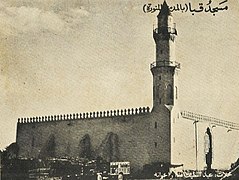 The original mosque, prior to its demolition in the 20th century
The original mosque, prior to its demolition in the 20th century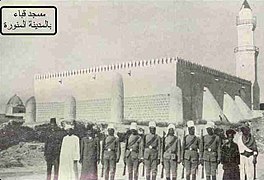 Ditto
Ditto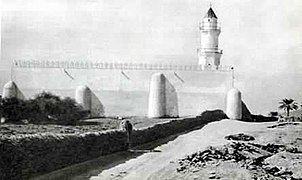 Ditto
Ditto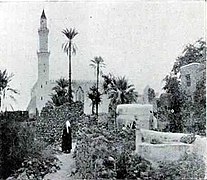 Ditto
Ditto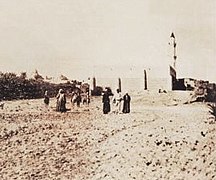 Ditto
Ditto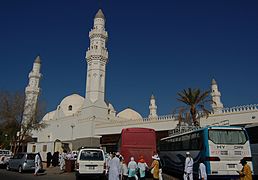 Rear view of the mosque in the 21st century
Rear view of the mosque in the 21st century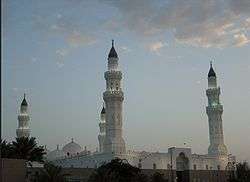 The mosque at dawn
The mosque at dawn
See also
- List of mosques in Saudi Arabia
- Lists of mosques
- Holiest sites in Islam
- Islamic architecture
- Islamic art
- Quba (city)
- Timeline of Muslim history
References
- Reid, Richard J. (12 January 2012). "The Islamic Frontier in Eastern Africa". A History of Modern Africa: 1800 to the Present. John Wiley and Sons. p. 106. ISBN 978-0470658987. Retrieved 15 March 2015.
- Michigan Consortium for Medieval and Early Modern Studies (1986). Goss, V. P.; Bornstein, C. V. (eds.). The Meeting of Two Worlds: Cultural Exchange Between East and West During the Period of the Crusades. 21. Medieval Institute Publications, Western Michigan University. p. 208. ISBN 0918720583.
- Mustafa Abu Sway. "The Holy Land, Jerusalem and Al-Aqsa Mosque in the Qur'an, Sunnah and other Islamic Literary Source" (PDF). Central Conference of American Rabbis. Archived from the original (PDF) on 2011-07-28.
- Dyrness, W. A. (2013-05-29). Senses of Devotion: Interfaith Aesthetics in Buddhist and Muslim Communities. 7. Wipf and Stock Publishers. p. 25. ISBN 978-1620321362.
- "Masjid Quba is the first mosque in Islam's history". Masjid Quba'. The Ministry of Hajj, Kingdom of Saudi Arabia. Retrieved 2010-10-19.
- Islam : a worldwide encyclopedia. Çakmak, Cenap. Santa Barbara, California. 2017-05-18. ISBN 978-1-61069-217-5. OCLC 962409918.CS1 maint: others (link)
- Islam : a worldwide encyclopedia. Çakmak, Cenap. Santa Barbara, California. 2017-05-18. ISBN 978-1-61069-217-5. OCLC 962409918.CS1 maint: others (link)
- Description of the new mosque and architectural documents at archnet.org Archived January 8, 2009, at the Wayback Machine
- Islam : a worldwide encyclopedia. Çakmak, Cenap. Santa Barbara, California. 2017-05-18. ISBN 978-1-61069-217-5. OCLC 962409918.CS1 maint: others (link)
- "Masjid al-Quba - 3D Virtual Tour". www.3dmekanlar.com. Retrieved 2019-12-09.
- Dr. Rasch (6 November 2002), "Alles muss von innen kommen", Gespräch mit dem Stuttgarter Architekten, Islamische Zeitung
- Enter Quba Mosque in the "Search the Hadith" box and check off all hadith collections. Archived October 21, 2014, at the Wayback Machine
- Sahih al-Bukhari, 2:21:284
- Sahih al-Bukhari, 2:21:285
- https://tafsirq.com/en/9-at-tawba/verse-108#tafsir-ibnu-katsir
- Quran 9:108
- Muhammad: The Messenger of Islam by Hajjah Amina Adil (p. 286)
- The Naqshbandi Sufi Tradition Guidebook of Daily Practices and Devotions by Hisham Kabbani (p. 301)
- Happold: The Confidence to Build by Derek Walker and Bill Addis (p. 81)
External links
| Wikimedia Commons has media related to Quba Mosque. |
- Virtues of Masjid Quba , Madina - Taken from Tafsir Ibn Kathir and other Saheeh Hadith

